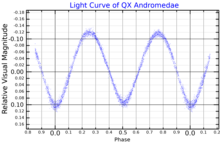QX Andromedae
Location of QX Andromedae (circled) in NGC 752 | |
| Observation data Epoch J2000 Equinox J2000 | |
|---|---|
| Constellation | Andromeda |
| Right ascension | 01h 57m 57.7818s[1] |
| Declination | +37° 48′ 22.4500″[1] |
| Apparent magnitude (V) | 11.28 – 11.5 variable[2] |
| Characteristics | |
| Spectral type | F6[2] |
| Apparent magnitude (B) | 11.77[3] |
| Apparent magnitude (R) | 11.23[3] |
| Apparent magnitude (G) | 11.2929[1] |
| Apparent magnitude (J) | 10.393[4] |
| Apparent magnitude (H) | 10.225[4] |
| Apparent magnitude (K) | 10.163[4] |
| Variable type | W UMa[2] |
| Astrometry | |
| Radial velocity (Rv) | 11.70±0.27[5] km/s |
| Proper motion (μ) | RA: 10.016±1.295 [1] mas/yr Dec.: −11.926±0.281[1] mas/yr |
| Parallax (π) | 2.2376 ± 0.0676 mas[1] |
| Distance | 1,460 ± 40 ly (450 ± 10 pc) |
| Orbit[6] | |
| Period (P) | 0.4121716 days |
| Semi-major axis (a) | 2.89±0.04 M☉ |
| Inclination (i) | 54.6±0.2° |
| Details[6] | |
| Primary | |
| Mass | 1.47±0.05 M☉ |
| Radius | 1.46±0.02 R☉ |
| Surface gravity (log g) | 4.27±0.03 cgs |
| Temperature | 6,440 K |
| Age | 1.34±0.06[7] Gyr |
| Secondary | |
| Mass | 0.45±0.02 M☉ |
| Radius | 0.88±0.02 R☉ |
| Surface gravity (log g) | 4.20±0.03 cgs |
| Temperature | 6420±20 K |
| Age | 1.34±0.06[7] Gyr |
| Other designations | |
| Database references | |
| SIMBAD | data |
QX Andromedae (often abbreviated to QX And) is an eclipsing binary in the constellation Andromeda. It varies from a maximum apparent visual magnitude of 11.28 to a minimum of 11.50. Since it is impossible to specify the onset time of the eclipses, it is classified as a W Ursae Majoris variable star.[2] It is also observed as an X-ray source[8] and is a member of the open cluster NGC 752.[7]
System
[edit]As a whole, the QX Andromedae system emits light like a stellar blackbody, with a F6 spectral type.[2] The two stars in the system complete an orbit every 9.892 hours; they are so close that their envelopes are touching each other. Their temperature is similar, but they have different radius and mass.[6] Since they belong to an open cluster, the age of this system is equal to the cluster estimated age (1.34±0.06 billion years).[7]
Variability
[edit]
The light curve of QX Andromedae shows almost equal eclipses; the primary eclipse occurs when the less massive star pass in front of the other one. The brightness variations are rather small for this system given the low orbital inclination of 55°.[6]
References
[edit]- ^ a b c d e f Brown, A. G. A.; et al. (Gaia collaboration) (August 2018). "Gaia Data Release 2: Summary of the contents and survey properties". Astronomy & Astrophysics. 616. A1. arXiv:1804.09365. Bibcode:2018A&A...616A...1G. doi:10.1051/0004-6361/201833051. Gaia DR2 record for this source at VizieR.
- ^ a b c d e N. N. Samus; O. V. Durlevich; et al. "QX And database entry". Combined General Catalog of Variable Stars (2017 ed.). CDS. Retrieved 2018-11-12.
- ^ a b Norton, A. J.; Wheatley, P. J.; West, R. G.; Haswell, C. A.; Street, R. A.; Collier Cameron, A.; Christian, D. J.; Clarkson, W. I.; Enoch, B.; Gallaway, M.; Hellier, C.; Horne, K.; Irwin, J.; Kane, S. R.; Lister, T. A.; Nicholas, J. P.; Parley, N.; Pollacco, D.; Ryans, R.; Skillen, I.; Wilson, D. M. (2007). "New periodic variable stars coincident with ROSAT sources discovered using SuperWASP". Astronomy and Astrophysics. 467 (2): 785. arXiv:astro-ph/0702631. Bibcode:2007A&A...467..785N. doi:10.1051/0004-6361:20077084. S2CID 16358048.
- ^ a b c Cutri, Roc M.; Skrutskie, Michael F.; Van Dyk, Schuyler D.; Beichman, Charles A.; Carpenter, John M.; Chester, Thomas; Cambresy, Laurent; Evans, Tracey E.; Fowler, John W.; Gizis, John E.; Howard, Elizabeth V.; Huchra, John P.; Jarrett, Thomas H.; Kopan, Eugene L.; Kirkpatrick, J. Davy; Light, Robert M.; Marsh, Kenneth A.; McCallon, Howard L.; Schneider, Stephen E.; Stiening, Rae; Sykes, Matthew J.; Weinberg, Martin D.; Wheaton, William A.; Wheelock, Sherry L.; Zacarias, N. (2003). "VizieR Online Data Catalog: 2MASS All-Sky Catalog of Point Sources (Cutri+ 2003)". CDS/ADC Collection of Electronic Catalogues. 2246: II/246. Bibcode:2003yCat.2246....0C.
- ^ Bilir, S.; Karataș, Y.; Demircan, O.; Eker, Z. (2005). "Kinematics of W Ursae Majoris type binaries and evidence of the two types of formation". Monthly Notices of the Royal Astronomical Society. 357 (2): 497–517. arXiv:astro-ph/0411291. Bibcode:2005MNRAS.357..497B. doi:10.1111/j.1365-2966.2005.08609.x.
- ^ a b c d Djurašević, G.; Yılmaz, M.; Baștürk, Ö.; Kılıçoğlu, T.; Latković, O.; Çalıșkan, Ş.; Christian, D. J.; Enoch, B.; Gallaway, M.; Hellier, C.; Horne, K.; Irwin, J.; Kane, S. R.; Lister, T. A.; Nicholas, J. P.; Parley, N.; Pollacco, D.; Ryans, R.; Skillen, I.; Wilson, D. M. (2011). "Physical parameters of close binaries QX Andromedae, RW Comae Berenices, MR Delphini, and BD +079° 3142". Astronomy and Astrophysics. 525: A66. arXiv:1011.3677. Bibcode:2011A&A...525A..66D. doi:10.1051/0004-6361/201014895. S2CID 119289612.
- ^ a b c d Agüeros, M. A.; Bowsher, E. C.; Bochanski, J. J.; Cargile, P. A.; Covey, K. R.; Douglas, S. T.; Kraus, A.; Kundert, A.; Law, N. M.; Ahmadi, A.; Arce, H. G. (July 2018). "A New Look at an Old Cluster: The Membership, Rotation, and Magnetic Activity of Low-mass Stars in the 1.3 Gyr Old Open Cluster NGC 752". The Astrophysical Journal. 862 (1): 33. arXiv:1804.02016. Bibcode:2018ApJ...862...33A. doi:10.3847/1538-4357/aac6ed. S2CID 119438236.
- ^ Belloni, T.; Verbunt, F. (January 1996). "Soft X-rays from the intermediate-age open cluster NGC 752". Astronomy and Astrophysics. 305: 806. Bibcode:1996A&A...305..806B.
- ^ Ren, A. B.; Zhang, X. B.; Luo, C. Q.; Luo, Y. P.; Deng, L. C.; Luo, Z. Q. (April 2011). "CCD Photometry of the W UMa type star QX Andromeda". New Astronomy. 16 (3): 194–198. Bibcode:2011NewA...16..194R. doi:10.1016/j.newast.2010.08.007. Retrieved 11 October 2021.

